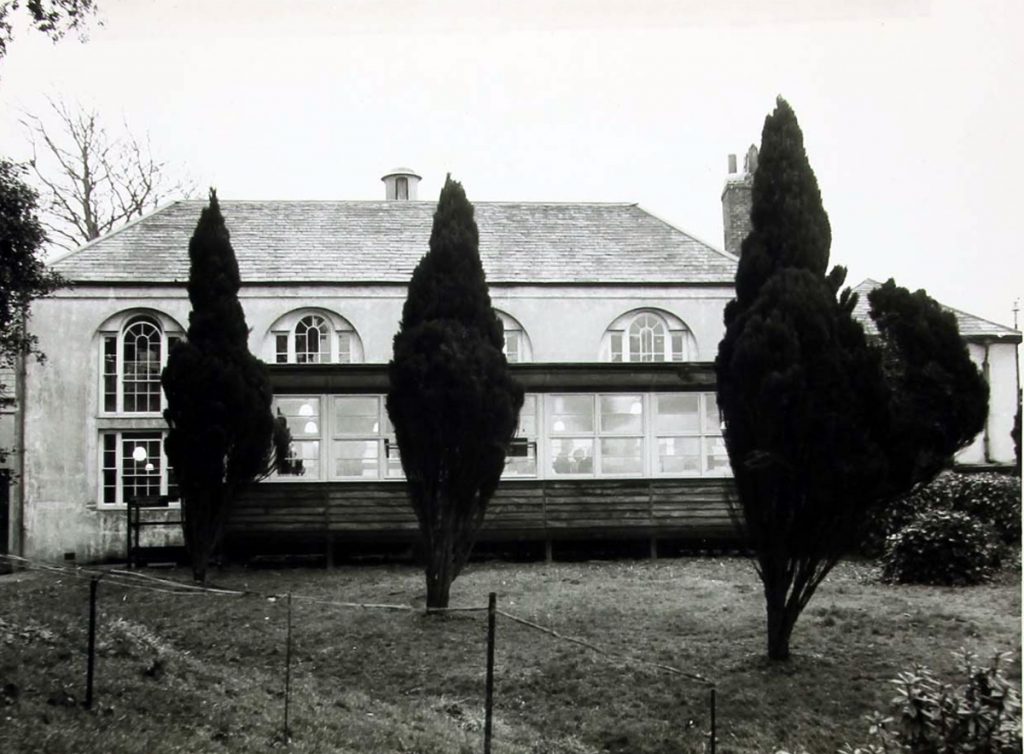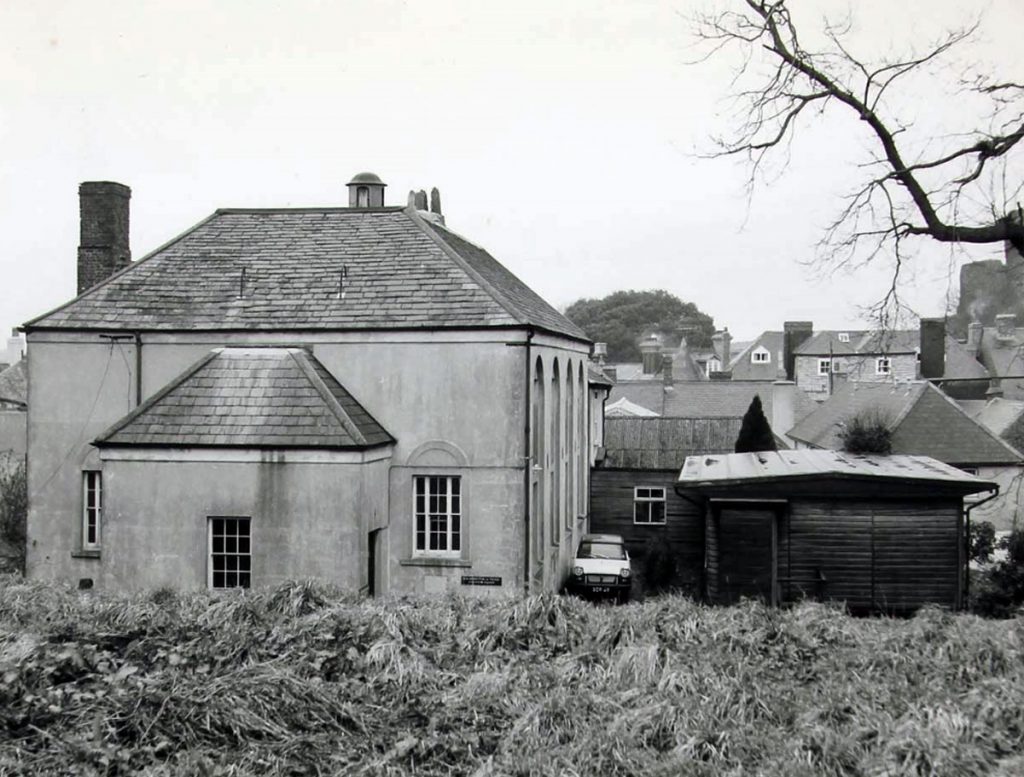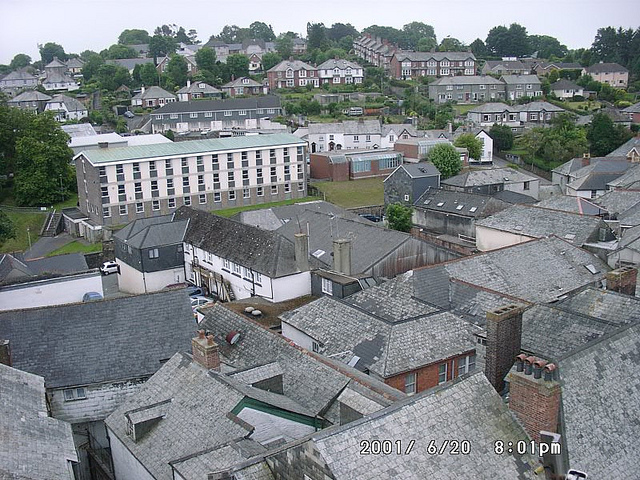.
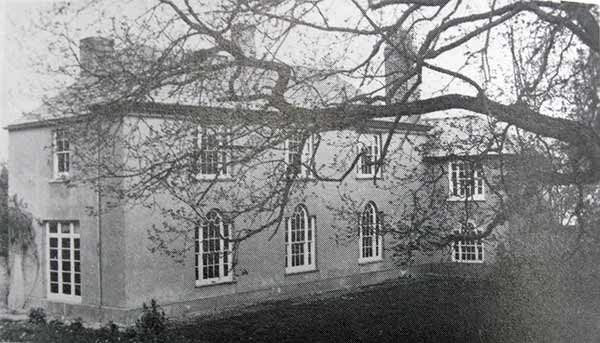
Madford House, or Madford as it was truly known, was built by Sir Hugh Piper shortly after the English Civil War. He gave it to his son, Philip, on his marriage to Mary Gaer, of Plymouth, and continued himself to reside at Tresmarrow.
Philip died in 1677, during his father’s lifetime, when only 32 years of age, and his son, Hugh, went to Madford. In due course, he moved to Tresmarrow and in 1710 conveyed Madford to his brother Granville, who was a barrister of the Middle Temple and who died in Bath in 1717, aged 38. He is one of the two men commemorated on the very large monument on the north side of St. Mary’s church.
RECORDER OF LAUNCESTON.
Granville was unmarried and at his death, Madford reverted to his brother Hugh. His second daughter, Philipa, married Richard Vyvyan, son of Sir Richard Vyvyan, of Trelowarren, near Helston. The young man was a barrister and Recorder of Launceston. He and his wife lived at Madford, though later they moved to Tresmarrow. Already, therefore, Madford was closely connected with the law.
In 1777 Philip Vyvyan, son and heir of Richard and Philippa conveyed Madford to the Rev. John Lethbridge, whose son, Christopher, was one of the founder attorneys who brought Madford into even closer association with the law. In an old manuscript dealing with the first part of the 19th century, the attorneys are described as “Lethbridge, Son and Gurney, Madford,” and in the turmoil of the time before and after the passing of the Reform Act, phrases such as “The influence of Madford” were commonplace. As the practice grew, it was found necessary to have an office elsewhere and to use the big house at Madford only as a residence. This office was at 11, Exeter Street.
DEPUTY RECORDERS AND TOWN CLERKS.
The Launceston Charter of 1555 gave the borough the right to have a Recorder and his Deputy and stated that the latter “shall be called the Town Clerk.” It is interesting to note that, though the charters of that time are in Latin, the two words “Towne Clerke” are in English. There is the reason to believe that later on, in spite of the definite instruction laid down by the charter, the Deputy Recorder and the Town Clerk were sometimes two distinct persons. In 1776 John Lethbridge was appointed to these offices and in 1780 Christopher Lethbridge took over the duties. Five years later he became also the local agent for the Royal Exchange Assurance Corporation, an agency held continuously to the 1960s by the firm through its amalgamation in 1929 with another old firm, Wilson, Parnall and Godwin. It was the eldest continuous agency of the Corporation in the country.
REPRESENTATIVE OF THE DUKE.
Christopher Lethbridge was the son of the Rev. John Lethbridge, Rector of St. Stephens and Sibella Luxmore, his wife. He was born in 1760, baptised on February 3rd 1761, married Mary Copland in 1785 and died on October 15, 1830, aged 69. He was a lawyer of considerable reputation and a prominent townsman. He was Town Clerk for three periods, 1780-1783, 1798-1809 and 1820-1830, and Mayor three times, in 1809, 1818 and 1826. He served also as Under-Sheriff for Cornwall. As the representative of the Duke of Northumberland, he exercised great influence in the district. At that time the Duke was the patron of the Parliamentary pocket boroughs of Launceston and the adjoining Newport. His first local agent and advisor was Humphrey Lawrence, whose office was in Castle Street, but when this Humphrey died in February 1788, his son, another Humphrey, then only nineteen years of age, was much too young to undertake the responsibility for the Duke’s work, and so the agency was transferred to the Lethbridge’s of Madford. In St. Mary Magdalene’s Church there is a stained glass window to the memory of Christopher Lethbridge and other members of the family.
Contemporary with Christopher Lethbridge was his near neighbour, Philip Gidley King, who was born in Southgate Street in 1758 and became Governor of New South Wales in 1800. The families were friendly and in due course were doubly joined by marriage, brother and sister marrying sister and brother. Christopher Lethbridge’s son, Robert Copland Lethbridge married Mary, youngest daughter of Philip Gidley King, and Harriet Lethbridge, Christopher’s second child, married Philip Parker King, who served in the Royal Navy and became a Rear Admiral. He was also a Fellow of the Royal Society. It was doubtless this friendship between the families that prompted Christopher Lethbridge to call another son John King, and it is he who followed in his father’s profession and joined him in partnership. Philip Gidley King was his godfather. It may be noted in passing that Gidley King was himself the godson of William Farnham, one of the leading men of Launceston, who became Mayor in 1787, 1793, and 1800.
THE BARONS OF TREGEARE.
John King Lethbridge was born in 1789 and died on May 28, 1861, aged 72, being buried at Egloskerry. He was twice married, firstly at Tresmeer in 1819 to Elizabeth Ann Baron, daughter of Jasper Baron and sole heiress of Tregeare, from which that large estate came into the possession of the Lethbridge’s. Her father built the present Tregeare house, standing in the Laneast parish; the old house, a short distance away, was in Egloskerry. The Barons were descended from George Baron, who bequeathed by his will, dated October 9, 1685, £10 annually to the old Launceston Grammar School, with a power for himself and his successors to nominate ten boys — a number subsequently reduced to five – to be educated there free of charge. Elizabeth Ann Baron died on February 1st, 1833 and later in the year her husband retired from practice. In 1835 he married Emma, daughter of the Rev. Edward Palmer, who outlived him by fifteen years.
Like his father, John King Lethbridge was an able attorney. He took a prominent part in the affairs of the borough and the county. He was Mayor of Launceston in 1815 and 1833 and Town Clerk from 1818 to 1820 and again from 1831 to 1833. He was a Deputy Lieutenant for Cornwall, a Justice of the Peace for both Cornwall and Devon and Chairman of the Cornwall Quarter Sessions for twenty years. He was Chairman of the local Board of Guardians and is believed to have given them for the Institution at Page’s Cross the painting which now hangs in Lawrence House — a copy of the central figure in Andrea del Sarto’s “Madonna delle Arpie,” in the original of which other figures of Francis of Assisi and John the Baptist stand on either side.
GURNEY COMES TO LAUNCESTON.
In 1828, the lawyers were joined by Charles Gurney and the firm became Lethbridge, Son and Gurney. Charles was born in 1805 to Gregory Gurney, a surgeon of Lifton. He had married Maria Rowe, daughter of Dr And Mrs Coryndon Rowe of Dockacre House. Her brother was Sir William Carpenter Rowe, who was the founder of the Rowe Dispensary.
Charles Gurney was Town Clerk from 1833 to 1867, being retained in that position on New Year’s Day 1836, when the new Town Council, reformed as a result of the Municipal Corporations Act, held its first meeting. He was the first Clerk of the local Board of Health, one of the trustees of the Rowe Dispensary and one of the founders of the Launceston Philosophic Society. With his partner, John King Lethbridge, he was particularly prominent in the Parliamentary election on December 1832, and for thirty years afterwards, when the Duke of Northumberland strove successfully to maintain his influence in the town in spite of the passing of the Reform Act in the previous June.
When John King Lethbridge left the firm, his partner, Charles Gurney, was joined by John Lethbridge Cowlard, who was the former’s nephew. His mother, Sarah, was the daughter of Christopher Lethbridge. On March 6th, 1810, at Launceston she married the Headmaster of the Grammar School, William Cowlard, Fellow of Balliol College, Oxford, and later Perpetual Curate of Laneast. He was born in 1780 and was the son of Thomas Cowlard, of Tiverton.
John Lethbridge Cowlard was born in 1811 and in 1841 purchased Madford House from his uncle. He was Borough Treasurer for many years and was Town Clerk from 1867 to 1874. He was Treasurer of the Launceston Savings Bank for more than fifty years and office in which he succeeded his uncle who was the first Treasurer. He followed Charles Gurney as Clerk to the Board of Health. He died on January 10th, 1885, at the age of 73.
CLERK OF THE COUNTY COUNCIL.
In 1859 the legal partnership of two was enlarged to three to include Lethbridge Cowlard, the eldest son of John Lethbridge Cowlard. When he died two years later at the early age of 24, his place was taken by Edward Fleetwood Kempson, who remained until 1870, when he went to London to practise. In that year, John Lethbridge Cowlard’s more widely known son, Christopher Lethbridge Cowlard, joined the firm, which became Cowlard and Cowlard in 1874, when Charles Gurney ceased to practice.
Christopher Lethbridge Cowlard was born in 1848, was admitted a Solicitor in 1869 and died at Madford on May 4th, 1925, aged 77. He was Mayor of Launceston in 1882. He became widely known throughout Cornwall when he was appointed Clerk of the County Council and Clerk of the Peace. As Registrar of the Diocese of Truro, he covered an even larger area. In 1885, after the death of his father, he took into partnership Charles Reginald Gerveys Grylls, a member of the large Cornish family which had produced many lawyers, but which was not connected with the Cowlard’s. Charles Grylls lived at Trenuth, Dunheved Road, and by 1889 he was Registrar of the County Court at Launceston. Unfortunately, he died on April 13th, 1926, less than a year after his partner, and the practice devolved upon Henry Lethbridge Cowlard. Christopher’s third son, who was born on June 2nd, 1879. But when he too died less than three years later, on February 25th, 1929, the firm’s legal business was transferred by amalgamation to the Westgate Street Solicitors, then Graham White, Llewellyn and Wilson, another very old firm, which traced its legal ancestry to Arthur Lawrence, who set up his practice in Westgate Street in the early part of the eighteenth century. It was his son, Humphrey, who built Lawrence House in Castle Street and had his office there. Madford House was then put up for sale and the Launceston Baptist Church, looking for larger premises than their Western Road Chapel purchased it.
Post & News, 8th January 1927: Madford House, Launceston, To Be Sold.
Madford House, Launceston, an old-fashioned residence, standing in its own grounds of roughly an acre, the property of the late Mr CL Cowlard, is to be sold by auction at the White Hart Hotel, Launceston, on Monday, February 7th. The property will be offered as a whole or in three Lots: Madford House, grounds and Lodge, 7.70 acres; Kitchen garden, 1.87 acres; stables and paddock 1.635 acres, while Windmill Lane cottages will also be sold in four Lots. It is pointed out that the property is peculiarly suitable for a private hotel or public institution, which, being situated in the middle of the town, is particularly ripe for immediate development. The auctioneers are Messrs. Rippon, Babinell & Co., Exeter, and the solicitors Messrs, Cowlard & Cowlard, Launceston, from whom plans and particulars may be obtained.
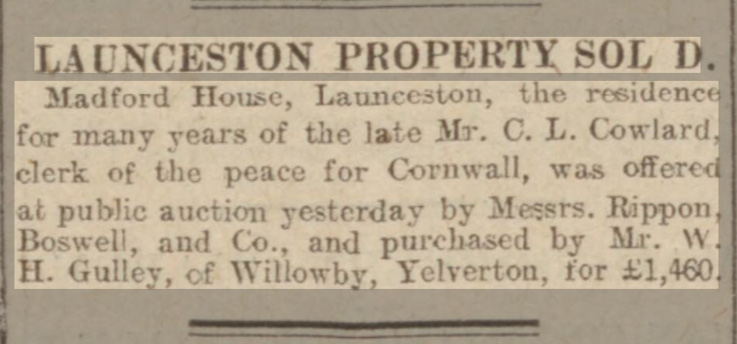
The newer wing of Madford house was converted into a church by rebuilding an outside wall to enclose a larger area. The rest of the building was used for various church rooms, and also as a Manse. The full cost of the Madford house purchase was £4000, but a much of this was matched by the sale of the old chapel and the subsequent sale of parts of the gardens of Madford house. Most of the house had been built early in the 17th century and was quite likely to have been the first house to have been built outside the town walls. In 1645 it is said to have accommodated the then Prince of Wales, later Charles II when he was resident in Cornwall. The house though with its age, was to prove expensive in its maintenance, something that the church didn’t consider when it was first purchased.
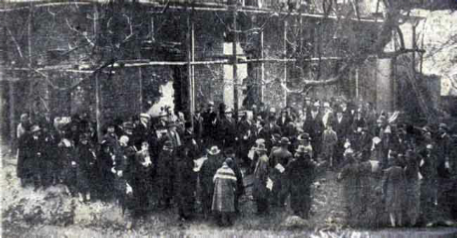
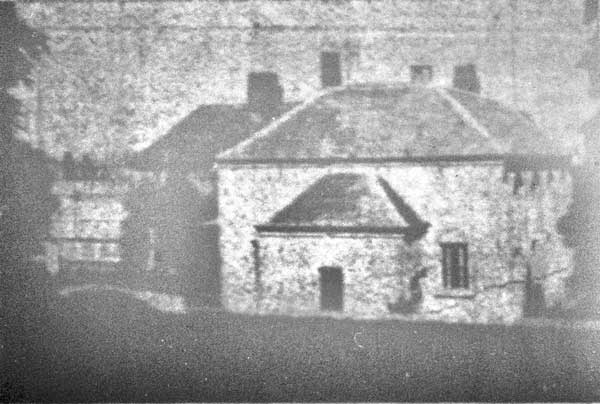
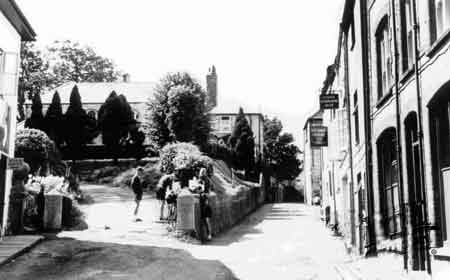
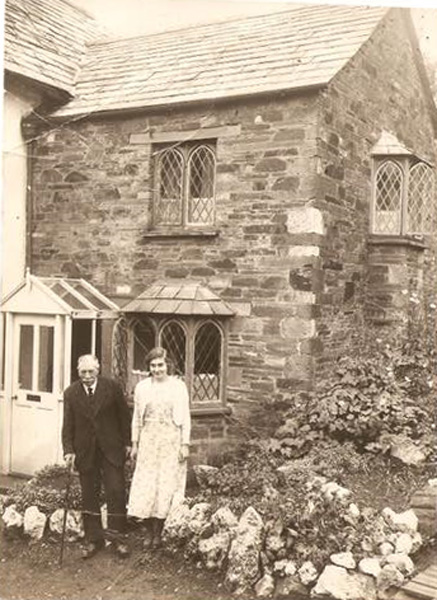
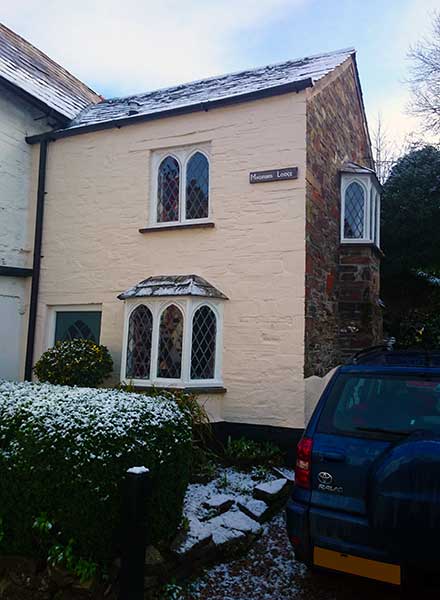
Above Madford Lodge. Photo courtesy of Kerran Prynne. And again in 2015. Madford Lodge is one of only two buildings that remain, the other is the old stables which is now the town bandroom below left.
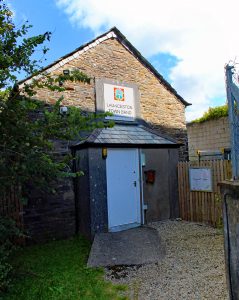
The Congregational church had been in decline for several years and in 1935, with a membership of only thirty-seven, it was decided to seek union with the Baptist church. A scheme for the outright union was rejected by both churches in 1936. In 1940 it was agreed that church should exist separately, but worship with the Baptists. On the first Sunday of June 1940, the congregations united in worship under the ministry of the Baptist minister, H J Harcup.
The two churches continued to worship in both their buildings, using each on alternate Sundays but by the end of the war, in 1945 it was agreed to seek full union and to concentrate the work in the Congregational premises. Even though the Congregational chapel was in a less convenient part of the town, it was far larger and better suited for worship. H J Harcup left at this time being replaced first by W P Hodge and then K E Hyde who was responsible for the implementation of uniting the churches. Madford house was leased to the Ministry of Works for office accommodation (below in 1960). The income derived for the lease of Madford house was completely taken by the extensive programme of building repairs to the said building, plus the renovation of the Castle Street premises.
Madford House was demolished in 1961 after being sold to the Town Council and in 1962 a new block owned by the Council was built and leased back to the Government for use by the Inland Revenue. These new Crown buildings were opened on August 28th, 1964.
Cornish & Devon Post, 1963:
The Proposed Crown Offices to be built on the Madford site at Launceston are now taking on a definite shape as this artist’s impression provided by the architects, Messrs Lucas, Roberts & Brown, of Exeter, clearly shows.
When the building has been completed it will accommodate approximately 80 office personnel, including members of the Inspector of Taxes Office and local representatives of other Government departments.
This new building is replacing the old Chapel at Madford and, until a further stage of the scheme has been completed, a limited car park will be provided for those using the offices. A year ago the important contract was almost lost when the Inland Revenue department contemplated moving to another town, but some rapid action by the Town Council and the North Cornwall Member of Parliament, Mr James Scott-Hopkins, at ministerial level, led to a change of heart.
The Inland Revenue decided to retain their establishment at Launceston and the Town Council got down to the task of getting the new building constructed as quickly as possible.
The estimated cost of the new building is £60,000. It is to be paid for by the annual income from the lease of the building to the Government.
The importance of the new offices far exceeds its brick and mortar value. Its very existence will preclude what might have been a startling decline in the town’s population and it established Launceston as a centre for a variety of Government departments for many years to come. It also
contributes a great deal towards the Town Council’s aim of making the Borough the centre for the district in the future.
This, of course, has a great bearing on the shopkeepers of the town whose livelihood depends on Launceston remaining a hustling, bristling little market town and civic centre.

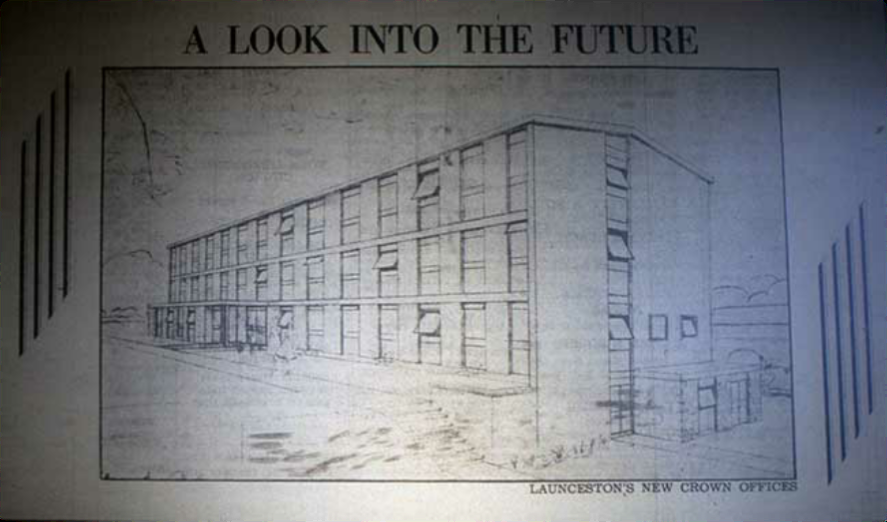
Above the plan for the new Crown Offices in 1961 and a view of the completed building taken from St. Mary’s Tower in 2001.
Cornish & Devon Post: 1964
Launceston’s New Crown Office. Opening Ceremony To Take Place Next Week.
Madford House, the new Crown Offices in Madford Lane, Launceston, is to be officially opened Thursday next [August 27th] in a public ceremony, by Mr James Scott-Hopkins, MP for North Cornwall, and the Parliamentary Secretary to the Ministry of Agriculture — The ceremony, which will be attended by Launceston Town Council members and their guests, is open to members of the public, who will be invited to inspect the building afterwards.
Post & News, 29 Aug 1964: Crown Offices.
The opening of Madford House – the new crown office building between Madford Lane and Bounsall’s Lane, Launceston – was officially performed yesterday, by Mr James Scott-Hopkins, MP for North Cornwall and parliamentary secretary to the ministry of agriculture.
Visits: 350

